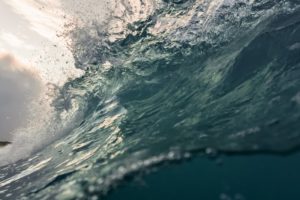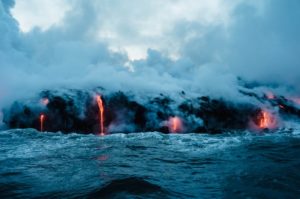Mother of all waves
Akku: Mommy, How is a Tsunami formed?
Well, that’s an interesting question! But before that do you have any idea what a Tsunami is?
Akku: Yes mom. It is a humongous wave. When it reaches the shore, it causes fatal damages. And I think it’s caused by underwater earthquake.
Wow! That’s absolutely correct. But I’ll explain little bit more. Do you know the word Tsunami comes from the Japanese word ‘tsu’, which means harbor and ‘nami’ which means wave? So it’s called Harbor Wave. They are commonly known as “Killer wave”.

Akku: Cool! But the Killer wave sounds bit scary, doesn’t it, mom? So continue…
Oh yeah, it’s scary. So, the Earth’s crust is made up of pieces called tectonic plates. When an earthquake happens these plates push against each other so hard that one of them slips or breaks. Imagine you are leaning against your friend. If you push against each other harder and harder, one or both of you will fall over. Same way when Earth’s plates push against each other, they can move a lot.
If an earthquake happens in the ocean, a large piece of Earth’s crust can be thrown upward or slips from side to side. The movement of a large chunk of Earth displaces the water above it, meaning it takes up the space where the water used to be. So where does the water go? It ripples out from the earthquake in waves.
Akku: Wow that’s amazing, but complicated.
I know, right? And this can also happen if a volcano erupts in the ocean. The lava flowing out of the volcano displaces the water around it. That water can turn into a large wave. If the earthquake or volcano is very big, then the wave can be very big, too.See, tsunami formed.
Big tsunamis usually begins in the deep ocean, where a large amount of water can be moved. As the wave moves closer to the shore, it grows taller and faster like a jet, forming a Tsunami.

Akku: So how can we tell that a Tsunami is coming?
Let’s say you are at the beach and feel an earthquake or rumbling in the ground, then the water recedes and gets pulled away from the coast leaving just the bare sand, then a Tsunami might be on the way. Go to high ground immediately!
Akku: So mommy if we see these signs can we escape a Tsunami?
Mostly we can, but experts says it gives very little time. It all depends on the size of the Tsunami formed and how soon you see it.
Akku: So mom, how big can a Tsunami get?
Out in the open ocean, tsunami formed waves are only about 3 feet high because the water is deep. However, as the water becomes shallow, the waves slow down and begin to grow. In some places a tsunami may cause the sea to rise vertically only a few inches or feet. In other places tsunamis have been known to surge vertically as high as 100 feet (30 meters).
Akku: What! 100 feet!!!!! That’s huge!
Yeah, almost the height of a 10 story building!
Akku: When did the last major Tsunami occur?
The 2004 Indian Ocean tsunami rank as the most devastating on record, causing waves as high as 30 feet (9 meters). More than 200,000 people lost their lives, many of them washed out to sea. Many people were killed because they went down to the beach to view the retreating ocean exposing the seafloor.
Akku: Oh that’s sad. If I see the seafloor, I would definitely run to higher ground.
That’s my girl! Do you want to know more facts about tsunamis?
Akku: Sure mom.
A tsunami is not a single wave but a series of waves, also known as a wave train. The first wave of a tsunami is usually not the strongest, successive waves get bigger and stronger. They are definitely not tidal waves and doesn’t behave like them. About 80% of tsunamis formed are within the Pacific Ocean’s “Ring of Fire”. They can travel at speeds of about 500 miles or 805 kilometers an hour, almost as fast as a jet plane.
Akku: Wow! That’s a lot!! Thanks mom. I’m all set to face a Tsunami if it ever comes.
Atta girl. Bye!